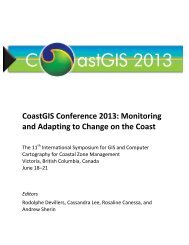in Context the SCotian Shelf - COINAtlantic
in Context the SCotian Shelf - COINAtlantic
in Context the SCotian Shelf - COINAtlantic
Create successful ePaper yourself
Turn your PDF publications into a flip-book with our unique Google optimized e-Paper software.
Guysborough county susta<strong>in</strong>able aQuaculture <strong>in</strong>itiative<br />
In 2002, <strong>the</strong> Guysborough County Susta<strong>in</strong>able Aquaculture Initiative (GCSAI) was <strong>in</strong>itiated to promote<br />
susta<strong>in</strong>able aquaculture development <strong>in</strong> Guysborough County that considers community values. The<br />
ultimate product of <strong>the</strong> <strong>in</strong>itiative was <strong>the</strong> GCSAI Tool, a GIS-based program that helps select more<br />
favourable areas for aquaculture. The Guysborough County Regional Development Authority uses <strong>the</strong><br />
tool to assist potential aquaculturists <strong>in</strong> select<strong>in</strong>g a site.<br />
The tool has water quality data for several different areas and can compare <strong>the</strong> properties of <strong>the</strong><br />
water with <strong>the</strong> requirements of 6 common aquaculture species. The tool helps narrow down possible<br />
sites, but any site chosen will still undergo environmental review and public consultation. As well, <strong>the</strong><br />
Guysborough County Regional Aquaculture Development Advisory Committee will review <strong>the</strong> application.<br />
Regional Aquaculture Development Advisory Committees (RADACs) make recommendations to<br />
<strong>the</strong> M<strong>in</strong>ister of Fisheries and Aquaculture for approv<strong>in</strong>g or disapprov<strong>in</strong>g applications for Aquaculture<br />
Licences and Leases. RADAC members are appo<strong>in</strong>ted by <strong>the</strong> M<strong>in</strong>ister from <strong>the</strong> local community; however,<br />
<strong>the</strong>re are RADACs <strong>in</strong> only a few areas of <strong>the</strong> prov<strong>in</strong>ce (MDG 2011, NSDFA 2011).<br />
The sector is largely made up of small, <strong>in</strong>dependent<br />
producers. However, production is concentrated<br />
<strong>in</strong> a few farms and it has been estimated<br />
that less than 20 % of <strong>the</strong> farms produce more<br />
than 80 % of <strong>the</strong> fish and shellfish (Gardner<br />
P<strong>in</strong>fold 2005). As of 2010, <strong>the</strong>re were about<br />
380 aquaculture sites <strong>in</strong> <strong>the</strong> prov<strong>in</strong>ce, however<br />
not all of <strong>the</strong>m are <strong>in</strong> production (NSDFA<br />
2011d).<br />
Economic Overview<br />
The aquaculture sector generated more than<br />
$50 million <strong>in</strong> revenues <strong>in</strong> 2007 from 10 000 t<br />
of product (Gardner P<strong>in</strong>fold 2009). There were<br />
about 750 full and part-time workers <strong>in</strong> <strong>the</strong><br />
<strong>in</strong>dustry <strong>in</strong> 2009 (NSDFA 2011c). In 2006, <strong>the</strong><br />
<strong>in</strong>dustry was estimated to have contributed $33.5<br />
million to Nova Scotia’s GDP from direct and<br />
sp<strong>in</strong>-off effects.<br />
3.4.3 Offshore Oil and Gas<br />
Offshore hydrocarbon exploration on <strong>the</strong> Scotian<br />
<strong>Shelf</strong> began <strong>in</strong> 1959 when Mobil Oil Canada was<br />
issued <strong>the</strong> first offshore exploration permit cover<strong>in</strong>g<br />
<strong>the</strong> Sable Island area. The first exploration well was<br />
drilled on Sable Island <strong>in</strong> 1967, followed two years<br />
later by <strong>the</strong> first discovery of significant quantities<br />
of natural gas on <strong>the</strong> Scotian <strong>Shelf</strong> by Shell Canada<br />
just south of Sable Island (CNSOPB 2011a). Between<br />
1972 and 1979, several significant hydrocarbon<br />
discoveries were made <strong>in</strong> <strong>the</strong> Sable Sub-bas<strong>in</strong><br />
with local reserves potentially exceed<strong>in</strong>g 18 trillion<br />
cubic feet (Tcf) and about 1 billion barrels (BB) of<br />
oil and gas liquids (Breeze and Horsman 2005).<br />
There are similar estimates for hydrocarbon reserves<br />
<strong>in</strong> o<strong>the</strong>r, less explored bas<strong>in</strong>s <strong>in</strong> Nova Scotia’s offshore:<br />
<strong>the</strong> deep water Scotian Slope, <strong>the</strong> Laurentian<br />
Sub-bas<strong>in</strong>, and <strong>the</strong> Shelburne Sub-bas<strong>in</strong> (Georges<br />
Bank) (Breeze and Horsman 2005).<br />
The Canada-Nova Scotia Offshore Petroleum Board<br />
(CNSOPB) manages petroleum exploration and<br />
development <strong>in</strong> most areas of offshore Nova Scotia.<br />
Currently, certa<strong>in</strong> areas of <strong>the</strong> offshore are closed to<br />
petroleum exploration. One of those areas is Georges<br />
Bank, where a moratorium has existed s<strong>in</strong>ce 1988<br />
and rema<strong>in</strong>s <strong>in</strong> effect to December 31, 2015.<br />
An exploration licence is needed for most petroleum<br />
exploration activities, <strong>in</strong>clud<strong>in</strong>g seismic explo-<br />
http://co<strong>in</strong>atlantic.ca/<strong>in</strong>dex.php/state-of-<strong>the</strong>-scotian-shelf<br />
39













